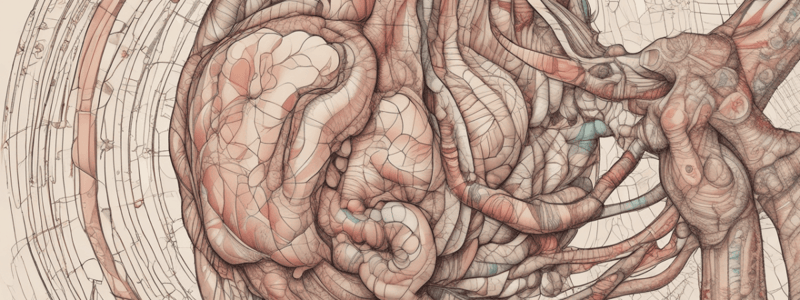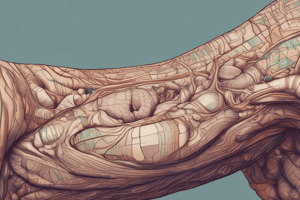Podcast
Questions and Answers
What is the primary function of the collagen fibers in the dermis?
What is the primary function of the collagen fibers in the dermis?
What is the approximate percentage of the dermis's dry weight that is made up of collagen fibers?
What is the approximate percentage of the dermis's dry weight that is made up of collagen fibers?
Which of the following cells is responsible for producing collagen fibers in the dermis?
Which of the following cells is responsible for producing collagen fibers in the dermis?
What is the function of the dermal papillae in the papillary region of the dermis?
What is the function of the dermal papillae in the papillary region of the dermis?
Signup and view all the answers
What is the name of the substance that fills the spaces between the fibers in the dermis?
What is the name of the substance that fills the spaces between the fibers in the dermis?
Signup and view all the answers
What is the term for the pressure exerted by the water in the dermis?
What is the term for the pressure exerted by the water in the dermis?
Signup and view all the answers
What type of cells are derived from monocytes and detect the presence of antigens?
What type of cells are derived from monocytes and detect the presence of antigens?
Signup and view all the answers
What is the primary function of macrophages in the dermis?
What is the primary function of macrophages in the dermis?
Signup and view all the answers
What is the main component of the hypodermis?
What is the main component of the hypodermis?
Signup and view all the answers
What hormone influences the distribution of adipose tissue in the body?
What hormone influences the distribution of adipose tissue in the body?
Signup and view all the answers
What is the primary function of mast cells in the dermis?
What is the primary function of mast cells in the dermis?
Signup and view all the answers
What is the primary function of adipocytes in the body?
What is the primary function of adipocytes in the body?
Signup and view all the answers
Study Notes
• The dermis is a layer of skin located beneath the epidermis and above the hypodermis, comprising a moderately dense connective tissue.
• The dermis has two main layers: the papillary region, which is the top layer and contains thin collagen fibers, and the reticular layer, which is the lower layer and contains thicker collagen fibers.
• The papillary region contains dermal papillae, which rise up into the epidermis, and is characterized by interconnected collagen fibers that provide flexibility.
• The reticular layer is named due to its network-like structure of collagen fibers, which run parallel to the surface of the body and provide tensile strength.
• The collagen fibers in the dermis make up about 70% of its dry weight and are responsible for its strength and toughness, similar to leather.
• Fibroblasts are specialized cells that produce collagen fibers, which are an essential component of the dermis.
• The dermis also contains elastic fibers that provide elasticity, allowing it to stretch and return to its original shape.
• The spaces between the fibers are filled with a glycoprotein substance called matrix or ground substance, which attracts water and gives the dermis its three-dimensional structure.
• The dermis contains a significant amount of water, known as dermal water, which contributes to its turgor pressure and gives it a firm, three-dimensional shape.
• In addition to collagen and elastic fibers, the dermis contains other cell types, including dendritic cells, macrophages, and mast cells, which play important roles in immune function and inflammation.
• Dendritic cells are derived from monocytes and detect the presence of antigens, communicating with the immune system to trigger a response.
• Macrophages are phagocytic cells that engulf and digest foreign substances and cellular debris.
• Mast cells contain histamine and other inflammatory mediators, which are released in response to trauma or injury, mediating a localized inflammatory response.
• The hypodermis is the layer of skin below the dermis, composed primarily of adipose tissue, which provides insulation and padding.
• Adipocytes are specialized cells that store fat in vacuoles, providing energy storage and insulation.
• The distribution of adipose tissue is influenced by hormones and sex, with males tend to store excess fat in the abdomen and females tend to store it more evenly throughout the body.
Studying That Suits You
Use AI to generate personalized quizzes and flashcards to suit your learning preferences.
Description
Learn about the layers of the dermis, including the papillary and reticular regions, and their components such as collagen fibers, elastic fibers, and cells like fibroblasts and mast cells. Understand the functions of the dermis and hypodermis, including providing strength, elasticity, and insulation to the skin.




